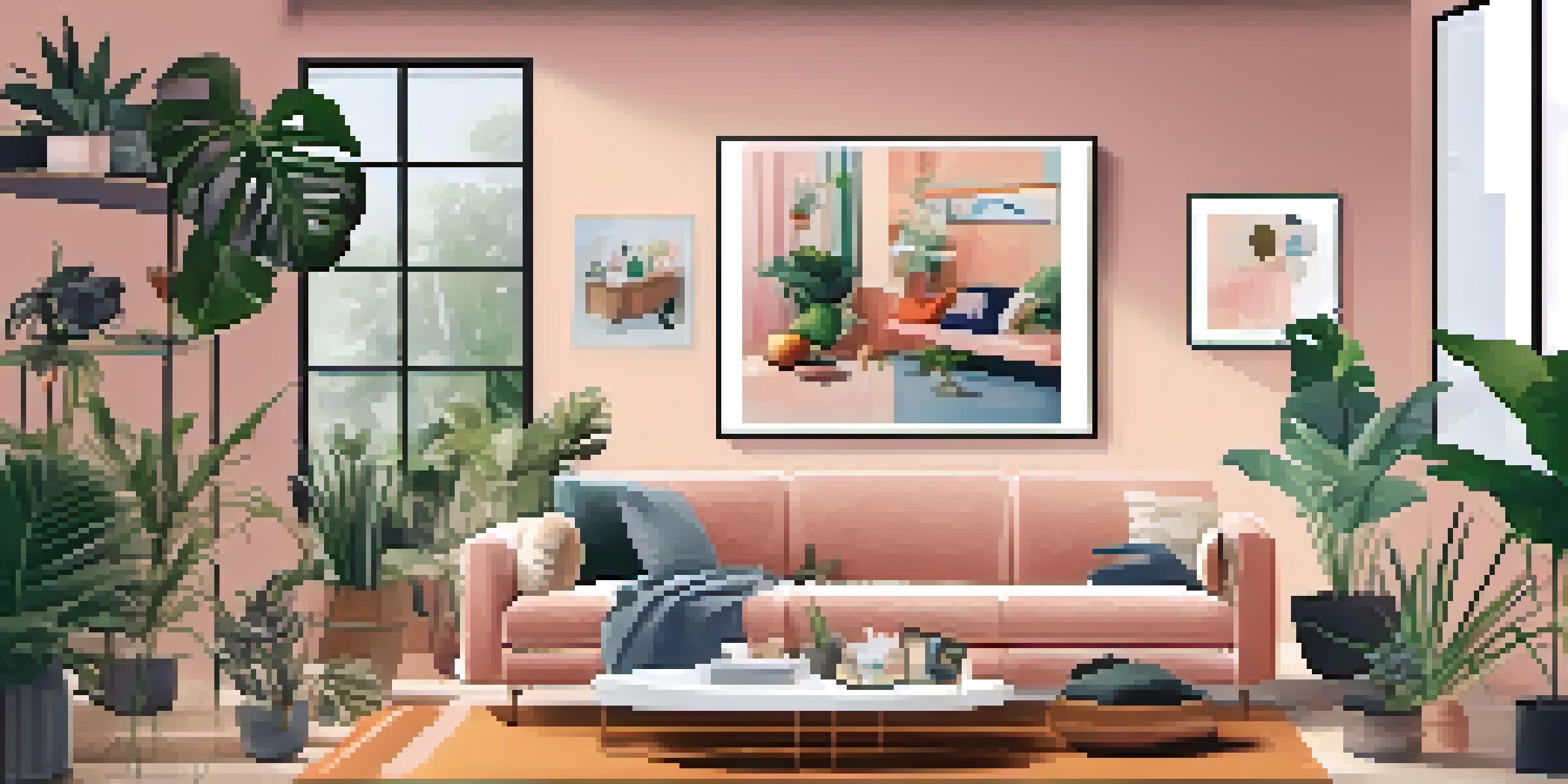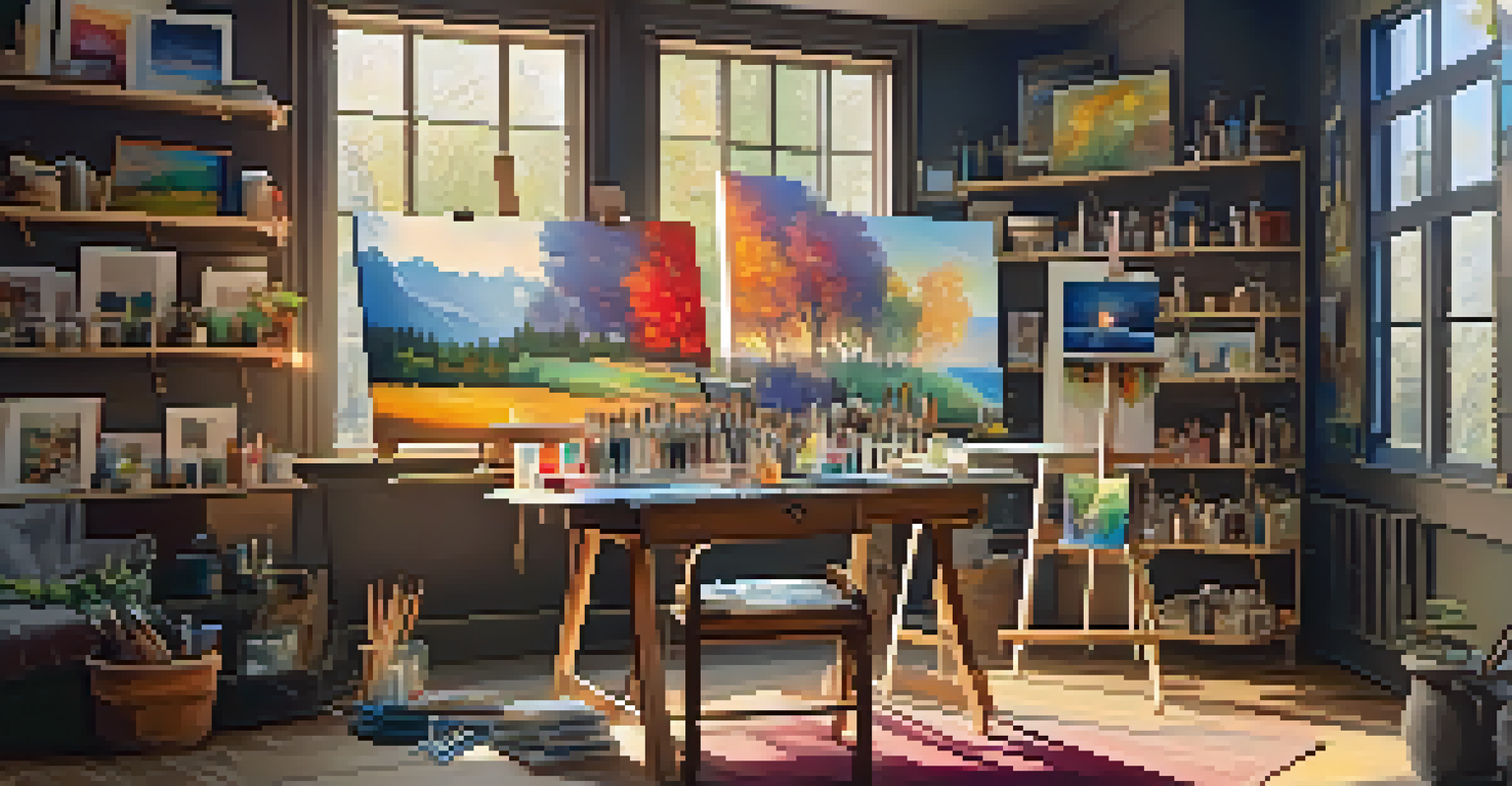The Influence of Social Media on Art Sales and Exposure

Understanding the Role of Social Media in Art Sales
Social media has revolutionized the way artists connect with potential buyers. Platforms like Instagram, Facebook, and Pinterest allow artists to showcase their work to a global audience at the click of a button. This shift means that an artist from a small town can gain the same visibility as a well-known name in the art world.
Art is not what you see, but what you make others see.
Moreover, social media serves as a marketplace where art can be directly sold. Artists can post images of their work along with prices, making transactions easier and more accessible than ever before. This democratization of art sales empowers artists to take control of their careers without relying solely on galleries or agents.
Additionally, the interactive nature of social media allows for real-time engagement between artists and their audience. This means artists can receive instant feedback, foster a community around their work, and even collaborate with fans or other creators, making the art sales process more dynamic and personal.
Building a Personal Brand Through Social Media
Creating a strong personal brand is essential for artists today, and social media is a powerful tool for this purpose. By sharing their artistic journey, techniques, and inspirations, artists can cultivate a unique identity that resonates with their audience. This storytelling aspect not only humanizes the artist but also establishes a deeper connection with potential buyers.

For example, an artist might share behind-the-scenes videos of their creative process, which can intrigue followers and draw them into their world. This kind of content can help demystify the art-making process and make the art more relatable. As followers feel more invested, they are more likely to support the artist by making purchases or sharing their work.
Visual Platforms Drive Art Exposure
Visual platforms enhance the visibility of artists' work through appealing imagery and strategic use of hashtags, boosting engagement and sales.
Furthermore, a consistent presence on social media reinforces an artist’s brand. Regular updates, engaging posts, and interaction with followers create a sense of familiarity and trust, encouraging art lovers to support the artist’s work. Over time, this can lead to increased sales and opportunities for collaboration.
The Impact of Visual Platforms on Art Exposure
Visual platforms like Instagram and Pinterest are particularly beneficial for artists as they focus on imagery. These platforms allow artists to showcase their work in a visually appealing way, which is crucial for attracting potential buyers. A stunning photo of an artwork can grab attention more effectively than words alone.
Social media is about sociology and psychology more than technology.
In addition, the use of hashtags on these platforms can significantly increase the visibility of an artist's work. By tagging relevant keywords, artists can reach users who are specifically interested in their style or medium. This targeted approach helps artists connect with a more engaged audience, increasing the chances of sales.
Moreover, visual platforms often feature algorithms that promote popular content, meaning that an artist's work can be seen by even more people if it gains traction. This organic reach can lead to a snowball effect, where increased visibility leads to more followers and, consequently, more sales.
The Role of Influencers in Art Promotion
Influencers have become key players in the art world, often bridging the gap between artists and potential buyers. When a popular influencer shares an artist’s work, it can lead to a significant spike in visibility and sales. This kind of endorsement can be a game-changer, especially for emerging artists looking to break into the market.
For instance, an influencer sharing a piece of art on their platform can introduce the artist to a completely new audience, drastically expanding their reach. This kind of promotion often feels more authentic than traditional advertising, making followers more likely to engage with the artist’s work.
Social Media Empowers Artists
Platforms like Instagram and Facebook enable artists to directly connect with buyers, democratizing art sales and providing greater visibility.
Furthermore, collaborations between artists and influencers can lead to unique projects that attract attention. These partnerships not only enhance the artist's visibility but also create engaging content for both parties, fostering a win-win situation in the art community.
The Importance of Engaging with Followers
Engagement is a crucial element in building a successful social media presence. Artists who actively respond to comments, share stories, and ask for feedback create a sense of community among their followers. This interaction not only strengthens relationships but also encourages followers to support their work.
For example, hosting live Q&A sessions or behind-the-scenes tours can give followers a deeper insight into the artist's process, fostering loyalty and interest. When followers feel connected to the artist, they are more likely to purchase artwork and promote it within their own circles.
Moreover, engaging with followers can lead to valuable feedback, allowing artists to refine their work and understand their audience better. This responsiveness can ultimately translate into increased sales as artists adapt to their followers' preferences and desires.
Challenges Artists Face on Social Media
While social media presents numerous opportunities for artists, it also comes with its own set of challenges. The sheer volume of content shared daily can make it difficult for individual artists to stand out. Artists must constantly innovate and engage their audience to avoid being lost in the noise.
Additionally, the pressure to maintain a polished online presence can be overwhelming. Artists may feel compelled to present their work in a certain way or adhere to trends, which can hinder their authentic expression. Balancing personal artistic vision with social media expectations can be a tightrope walk.
Building Brands Through Engagement
Artists can cultivate their personal brand by sharing their creative journey, leading to deeper connections and increased sales.
Furthermore, the potential for negative feedback or criticism can deter some artists from fully embracing social media. However, learning to navigate these challenges is part of the journey and can ultimately lead to growth and resilience in an artist’s career.
Future Trends: Social Media and the Art Market
As technology continues to evolve, so too will the influence of social media on the art market. Emerging platforms and features, such as augmented reality (AR) and virtual galleries, are set to change how art is showcased and sold. Artists will have even more innovative ways to engage with their audience and market their work.
Moreover, the rise of NFTs (non-fungible tokens) has already begun to reshape the art landscape. Social media plays a crucial role in promoting these digital artworks, allowing artists to reach tech-savvy audiences and expand their sales avenues. This trend indicates a shift towards more diverse and accessible forms of art.

In conclusion, social media's influence on art sales and exposure is profound and continuously evolving. By embracing these changes and adapting to new trends, artists can leverage social media to enhance their visibility, build their brands, and ultimately thrive in the art market.